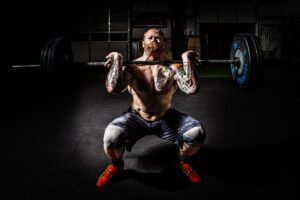Table of Contents:
Introduction
When it comes to sculpting a powerful and aesthetic physique, strong and well-defined legs are an essential component. While many focus on traditional weightlifting for leg development, the world of calisthenics offers a unique and effective approach to building leg muscles. In this comprehensive guide, we will delve into the realm of calisthenics leg workouts, exploring the best exercises for muscle growth and size. Prepare to unlock your leg potential and embark on a journey of transformation through bodyweight training.
Workout Plan:
#1: Bodyweight Squats – 3 sets of 15 reps

Bodyweight squats are a fundamental yet potent exercise for building leg strength and size. To perform a bodyweight squat:
- Stand with your feet shoulder-width apart.
- Engage your core and keep your chest upright.
- Lower your hips back and down, as if sitting in an imaginary chair.
- Keep your knees aligned with your toes and your weight on your heels.
- Descend until your thighs are parallel to the ground or lower.
- Push through your heels to return to the starting position.
Targets: Quadriceps, Hamstrings, Glutes, Calves
#2: Walking Lunges – 3 sets of 12 reps (per leg)

Lunges target various leg muscles while improving balance and stability. Here’s how to perform a forward lunge:
- Stand tall with your feet hip-width apart.
- Take a step forward with one leg, lowering your back knee toward the ground.
- Both knees should form 90-degree angles.
- Push off the front foot to return to the starting position. Explore variations like reverse lunges and lateral lunges for well-rounded leg development.
Targets: Quadriceps, Hamstrings, Glutes, Calves, Core
#3: Step-Ups – 3 sets of 10 reps (per leg)

Step-ups engage your quadriceps, hamstrings, and glutes while mimicking real-life movements. To do step-ups:
- Find a sturdy surface or bench.
- Step onto it with one foot and drive through your heel to lift your body.
- Fully extend your hip and knee at the top.
- Step back down with control. Alternate legs for each step and ensure balanced muscle engagement.
Targets: Quadriceps, Hamstrings, Glutes, Calves
#4 Broad Jumps – 3 sets of 5 jumps

Broad jumps and box jumps improve explosive power and coordination. For broad jumps:
- Start with feet hip-width apart.
- Dip into a partial squat, then explode forward, jumping as far as possible.
- Land softly with slightly bent knees. For box jumps:
- Stand facing a sturdy box or platform.
- Dip into a quarter squat and explosively jump onto the box.
- Land with both feet fully on the box and stand up straight.
Targets: Quadriceps, Hamstrings, Glutes, Calves
#5: Box Jumps – 3 sets of 15 reps

A compound and demanding exercise designed to increase explosiveness and power:
- Stand on the edge of a step or platform, with your heels hanging off.
- Lower your heels below the step’s level, feeling a stretch in your calves.
- Rise onto your toes by pushing through the balls of your feet.
- Lower your heels back down below the step’s level to complete one rep.
Targets: Quadriceps, Hamstrings, Glutes, Calves
#6: Pistol Squats (advanced) – 3 sets of 8 reps (per leg)

Pistol squats demand exceptional balance and strength. Here’s how to perform them:
- Balance on one leg, extending the other leg straight in front of you.
- Lower yourself by bending your supporting knee while keeping the extended leg parallel to the ground.
- Descend as far as your mobility allows.
- Push through your supporting heel to return to the starting position.
Targets: Quadriceps, Hamstrings, Glutes, Calves, Core
I. The Science Behind Calisthenics Leg Training
To fully appreciate the effectiveness of calisthenics leg workouts, it’s crucial to understand the science behind muscle growth. Muscle hypertrophy, the process of muscle fibers increasing in size, is the driving force behind impressive leg gains. Calisthenics, with its focus on bodyweight resistance, triggers hypertrophy through controlled movements that engage multiple muscle groups simultaneously. This holistic approach promotes balanced leg development while enhancing overall functional strength.
II. Essential Principles of Calisthenics Leg Workouts
At the core of calisthenics leg training lie two fundamental principles: bodyweight resistance and progressive overload. The former leverages your body weight as resistance, utilizing it to challenge your leg muscles. The latter principle involves gradually increasing the intensity of your exercises over time. By consistently pushing your limits and embracing discomfort, you stimulate muscle adaptation and growth.
III. Mastering the Basics: Foundational Calisthenics Leg Exercises
Let’s dive into the cornerstone of your calisthenics leg workout: bodyweight squats. This foundational movement engages your quadriceps, hamstrings, and glutes, setting the stage for well-rounded leg development. Transitioning to lunges, you target each leg individually, improving muscular imbalances and enhancing stability. Furthermore, step-ups offer a practical yet potent way to build leg strength, replicating real-life movements and cultivating a balanced physique.
IV. Elevating the Challenge: Advanced Calisthenics Exercises
As your leg strength increases, it’s time to explore advanced calisthenics exercises. Pistol squats demand exceptional balance and control as you lower yourself on one leg. Broad jumps and box jumps introduce explosive power, requiring rapid muscle contractions for maximal height and distance. Nordic hamstring curls emerge as a potent tool for hamstring development, emphasizing both eccentric and concentric muscle actions.
V. Designing Your Calisthenics Leg Workout Routine
Crafting a well-structured calisthenics leg workout is crucial for optimal results. Begin with a dynamic warm-up, incorporating leg swings and hip mobility exercises to prepare your muscles for action. Progress to compound movements like squats and lunges, gradually increasing resistance or difficulty. Conclude with targeted exercises such as calf raises and hamstring curls.
VI. Overcoming Plateaus and Maximizing Progress
In any fitness journey, plateaus are inevitable. To conquer them, embrace variation and periodization. Alter exercise angles, incorporate tempo changes, and manipulate rest periods to keep your muscles guessing. Furthermore, progress isn’t solely about physical adaptation—it’s also mental. Cultivate a resilient mindset, channeling determination to overcome obstacles and continuously push your limits.
VII. The Role of Nutrition in Calisthenics Leg Muscle Growth
Your calisthenics leg workout is only as effective as your nutritional support. Protein plays a pivotal role, providing the building blocks for muscle repair and growth. Carbohydrates fuel your workouts, replenishing glycogen stores for sustained energy. Adequate hydration and micronutrient intake ensure efficient muscle recovery, allowing you to maximize the benefits of your training.
VIII. Avoiding Common Mistakes in Calisthenics Leg Training
Form and technique are non-negotiable when it comes to calisthenics leg exercises. Prioritize proper alignment to prevent injuries and optimize muscle engagement. Additionally, rest and recovery are often underestimated. Listen to your body, allowing ample time for muscles to recuperate and grow.
IX. Real-Life Success Stories: Transformation Through Calisthenics Leg Training
Drawing inspiration from real-life success stories showcases the remarkable potential of calisthenics leg training. Individuals from various backgrounds have achieved impressive leg gains through dedication and consistency. Their journeys underscore the importance of setting goals, staying committed, and embracing the process.
FAQs:
Can I build substantial leg muscles with calisthenics alone?
Absolutely. Calisthenics leg exercises, when performed with proper technique and progressive overload, can lead to significant muscle growth and size.
How often should I train my legs with calisthenics?
Aim for 2-3 leg workouts per week, allowing adequate rest between sessions for muscle recovery.
Are calisthenics leg workouts suitable for beginners?
Yes, calisthenics offers scalable exercises that cater to all fitness levels. Start with foundational movements and gradually progress to more advanced exercises.
Conclusion: Unleash Your Leg Potential with Calisthenics
Embarking on a calisthenics leg workout journey is a testament to your commitment to fitness and self-improvement. By integrating science-backed principles, mastering essential exercises, and continually challenging yourself, you unlock the door to powerful, well-defined legs. Embrace the holistic approach of calisthenics, and watch your leg muscles transform into a symbol of strength, endurance, and aesthetic excellence. Get ready to take strides towards your leg goals and stand tall as a true calisthenics athlete.
Note: Always consult a fitness professional or healthcare provider before starting a new exercise routine, especially if you have any pre-existing health conditions.



